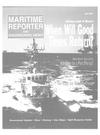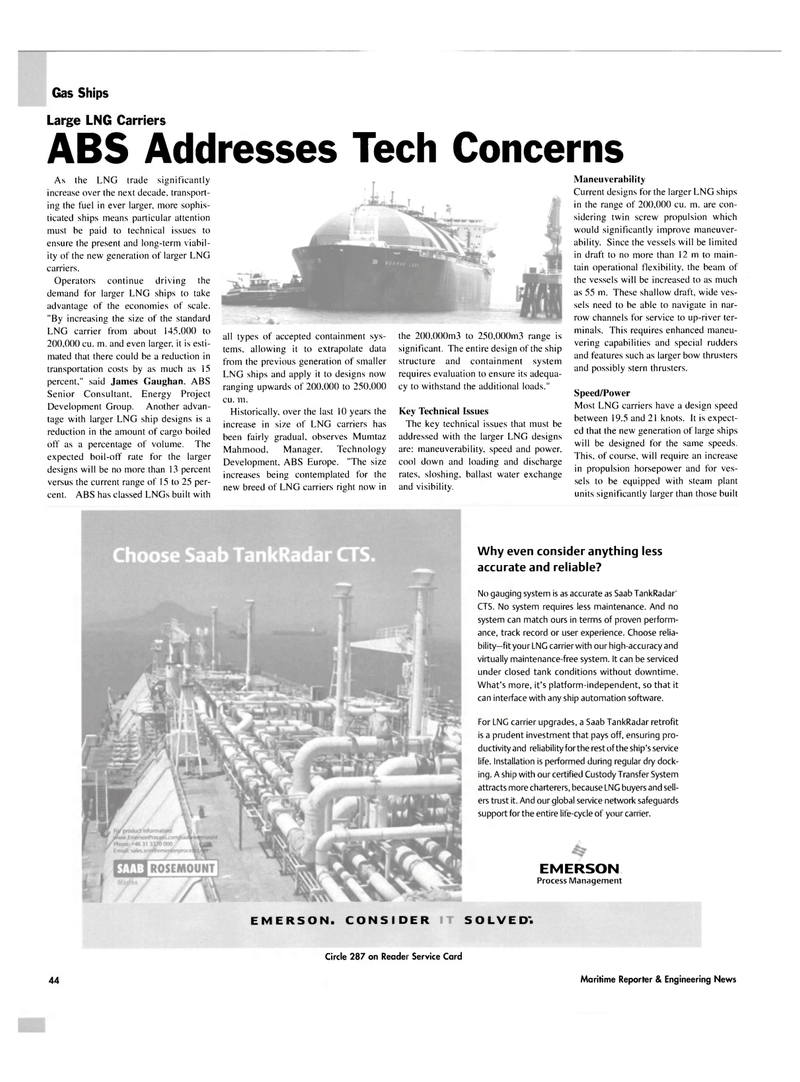
Page 46: of Maritime Reporter Magazine (April 2004)
Offshore Technology Yearbook
Read this page in Pdf, Flash or Html5 edition of April 2004 Maritime Reporter Magazine
Gas Ships
Large LNG Carriers
ABS Addresses Tech Concerns
As the LNG trade significantly increase over the next decade, transport- ing the fuel in ever larger, more sophis- ticated ships means particular attention must be paid to technical issues to ensure the present and long-term viabil- ity of the new generation of larger LNG carriers.
Operators continue driving the demand for larger LNG ships to take advantage of the economies of scale. "By increasing the size of the standard
LNG carrier from about 145,000 to 200,000 cu. m. and even larger, it is esti- mated that there could be a reduction in transportation costs by as much as 15 percent," said James Gaughan. ABS
Senior Consultant. Energy Project
Development Group. Another advan- tage with larger LNG ship designs is a reduction in the amount of cargo boiled off as a percentage of volume. The expected boil-off rate for the larger designs will be no more than 13 percent versus the current range of 15 to 25 per- cent. ABS has classed LNGs built with all types of accepted containment sys- tems. allowing it to extrapolate data from the previous generation of smaller
LNG ships and apply it to designs now ranging upwards of 200.000 to 250.000 cu. 111.
Historically, over the last 10 years the increase in size of LNG carriers has been fairly gradual, observes Mumtaz
Mahmood, Manager, Technology
Development, ABS Europe. "The size increases being contemplated for the new breed of LNG carriers right now in the 200,000m3 to 250,000m3 range is significant. The entire design of the ship structure and containment system requires evaluation to ensure its adequa- cy to withstand the additional loads."
Key Technical Issues
The key technical issues that must be addressed with the larger LNG designs are: maneuverability, speed and power, cool down and loading and discharge rates, sloshing, ballast water exchange and visibility.
Maneuverability
Current designs for the larger LNG ships in the range of 200,000 cu. m. are con- sidering twin screw propulsion which would significantly improve maneuver- ability. Since the vessels will be limited in draft to no more than 12 m to main- tain operational flexibility, the beam of the vessels will be increased to as much as 55 m. These shallow draft, wide ves- sels need to be able to navigate in nar- row channels for service to up-river ter- minals. This requires enhanced maneu- vering capabilities and special rudders and features such as larger bow thrusters and possibly stern thrusters.
Speed/Power
Most LNG carriers have a design speed between 19.5 and 21 knots. It is expect- ed that the new generation of large ships will be designed for the same speeds.
This, of course, will require an increase in propulsion horsepower and for ves- sels to be equipped with steam plant units significantly larger than those built
Why even consider anything less accurate and reliable?
No gauging system is as accurate as Saab TankRadar'
CTS. No system requires less maintenance. And no system can match ours in terms of proven perform- ance, track record or user experience. Choose relia- bility—fit your LNG carrier with our high-accuracy and virtually maintenance-free system. It can be serviced under closed tank conditions without downtime.
What's more, it's platform-independent, so that it can interface with any ship automation software.
For LNG carrier upgrades, a Saab TankRadar retrofit is a prudent investment that pays off, ensuring pro- ductivity and reliability for the restofthe ship's service life. Installation is performed during regular dry dock- ing. A ship with our certified Custody Transfer System attracts more charterers, because LNG buyers and sell- ers trust it. And our global service network safeguards support for the entire life-cycle of your carrier.
EMERSON
Process Management
EMERSON. CONSIDER SOLVED". 44
Circle 287 on Reader Service Card
Maritime Reporter & Engineering News

 45
45

 47
47
